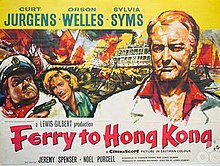Ferry to Hong Kong
This article needs additional citations for verification. (December 2009) |
| Ferry to Hong Kong | |
|---|---|
 Original UK quad by Brian Bysouth | |
| Directed by | Lewis Gilbert |
| Produced by | George Maynard |
| Starring | Curt Jürgens Orson Welles Sylvia Syms Jeremy Spenser |
| Cinematography | Otto Heller |
| Edited by | Peter R. Hunt |
| Music by | Kenneth V. Jones |
Production company | |
| Distributed by | Rank Film Distributors 20th Century Fox (US) |
Release date |
|
Running time | 112 minutes |
| Country | United Kingdom |
| Language | English |
| Budget | £500,000[2] |
Ferry to Hong Kong is a 1959 British melodrama/adventure film directed by Lewis Gilbert and starring Curt Jürgens, Sylvia Syms, Orson Welles and Jeremy Spenser.[1]
Plot
Mark Conrad, a debonair Anglo-Austrian former playboy and junk owner, now an alcoholic down-and-out, is expelled from Hong Kong. He is placed on an ancient ferry boat, the Fa Tsan (known to its crew as the Fat Annie), despite the protests of the pompous owner, Captain Cecil Hart.
He travels to Macau, but is refused entry for the same reason he was expelled from Hong Kong. He engages the captain in a card game and wins the right to 'live' on board. His charming manner endears him to the crew and to an attractive teacher Liz Ferrers, a regular passenger.
The ferry is nearly wrecked in a typhoon, but Conrad wrests command from the cowardly and drunken captain and saves the ship. Drifting out of control near the Chinese coast, they are boarded by pirates, led by Chinese-American Johnny Sing-up. Sing-up reveals that Hart is a former conman who won the ship in a crooked card-game.
Conrad becomes a hero when he saves the ship, and is allowed to stay in Hong Kong. He is tempted to continue his budding relationship with Liz, but decides to resist it until he has 'beaten the dragon'.
Cast
- Curt Jürgens as Mark Bertram Conrad
- Orson Welles as Captain Cecil Hart
- Sylvia Syms as Miss Liz Ferrers
- Jeremy Spenser as Miguel Henriques, 1st Officer
- Noel Purcell as Joe Skinner, ship's engineer
- Margaret Withers as Miss Carter
- John Wallace as Hong Kong Police Inspector
- Roy Chiao as Johnny Sing-up
- Shelley Shen as Foo Soo
- Louis Seto as Tommy Cheng
- Milton Reid as Yen, Sing-Up's Partner
Background
The film was among those movies made by Rank to appeal to the international market, involving colour and location filming.[2] Rank had rationalised its film production arm, decreasing overall output but putting more money in a certain number of films. Rank chairman John Davis said: "It is vital that the greatest possible financial encouragement should be given to the making of important films: for these the public will gladly pay. The emphasis will be on the more expensive and important film."[3]
The film was to originally star Burl Ives and contract star Peter Finch.[4] However this soon became Curt Jurgens and Orson Welles.[5] (A number of Rank movies had German stars around this time as the German market was seen as very important.[6])
The original title was Night Ferry to Hong Kong. The movie had one of the largest budgets in the history of Rank.[7]
Lewis Gilbert described Ferry to Hong Kong as "my nightmare film". Orson Welles, he said, "never cared about his fellow actors, never cared about the director". Gilbert says "everything was wrong with the film - principally Orson Welles".[8]
Originally Jurgens was meant to play the ship captain and Welles the tramp but John Davis, head of Rank, insisted they change roles. The film was shot entirely on location. In Hong Kong the production team bought a boat that could be converted into a paddle steamer and used local labour to build a full sized studio stage and crane for the CinemaScope camera. The film was shot with guide tracks and every line of dialogue was re-recorded and re-synched in Pinewood. Welles and Jurgens hated each other and Gilbert had trouble filming them in the same shot. Welles insisted on wearing a false nose and at one point held up filming for two days while he could find his nose.[2]
Reception
The film received bad reviews in England and was a disaster at the box office.[2][7]
The Los Angeles Times called it "a very funny comedy-drama".[9]
References
- ^ a b "Ferry to Hong Kong (1959)". British Film Institute. Retrieved 9 August 2019.
- ^ a b c d British Cinema of the 1950s: The Decline of Deference by Sue Harper, Vincent Porter Oxford University Press, 2003 p 54–55
- ^ "BRITISH DOSSIER: Rank Theatre Chain, Production List Reduced -- Outlet -- Other Items" by STEPHEN WATTS LONDON.. New York Times 26 Oct 1958: X7.
- ^ "Burl Ives Signed for British Film: TV Grabs Unreleased Movie; Rodolfo Hoyos Saves 'Villa!!'" Scheuer, Philip K. Los Angeles Times 12 Sep 1958: B7.
- ^ "Film Plays and Players" The Christian Science Monitor 20 Sep 1958: 11.
- ^ "Rank's World Market Yen Cues Cast Shifts". Variety. 24 September 1958. p. 11.
- ^ a b "AMERICANS IN ACTION ON BRITAIN'S FILM FRONT: Shooting 'Suddenly' -- New Departure For Miss Dandridge -- Other Items" by STEPHEN WATTS LONDON.. New York Times 19 July 1959: X5.
- ^ Lewis Gilbert's comments were made in an interview on the BBC Radio 4 programme Desert Island Discs transmitted on 25 June 2010.
- ^ "Sophia Loren Cavorts as 'The Millionairess': SOPHIA" Stinson, Charles. Los Angeles Times 24 Mar 1961: B10
